You are currently browsing the retailing category
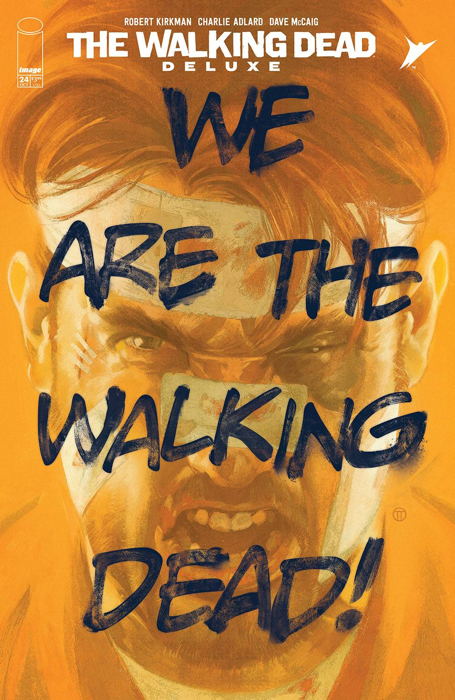
What’s great about this newest issue of Walking Dead‘s color reprints is how they just lean into the somewhat notorious “we ARE the Walking Dead!” declaration Rick makes in the issue. All but one of the variant covers features the phrase itself or a paraphrasing thereof, giving a hearty “take that, haters” to everyone who razzed the…on-the-noseness of it all.
I don’t know how the actual regular readers of The Walking Dead responded to the issue at the time. The color reprints also include the original letter columns, so I suppose I’ll find out myself in a month or two. My guess is that the fans invested in the book found it profound, while the comicsblogosphere of late 2005 probably happily snarked away at it out of its regular context. And while I don’t think I commented on it then, I would occasionally reference it for a gag, such as this recent tweet.
I’m pretty sure I’ve noted before that I am now reading The Walking Dead in its color reprint form, as I missed out on the series the first time. I mean, sure, not like there wasn’t plenty of ways to catch up on the book, what with all the trade paperback/hardcover/omnibus options, but I never seemed to get around to it. And now that it’s coming out in single issue form again every fortnight or so, it’s easy for me to just grab ‘n’ read them as they arrive.
Aaaaaaand…even in context, after having read issues #1 through #23, the “WE ARE THE WALKING DEAD!” exclamation at the end of #24 still comes across as perhaps just a tad overwrought. Too much Cochrane in First Contact saying “you’re all astronauts on some kind of star trek?” level of forced, dragging what should be subtext into just straight up text. On the other hand, if I wanted subtlety, I suppose I wouldn’t be reading a comic book called “The Walking Dead.”
All that said, it does come at the end of an effective extended speech from Rick, marking a turning point for our characters in this series. It’s essentially Rick emphasizing over and over that the old world, the old ways of doing things, are over, that everything you were used to is gone, and that they were going to have to get accustomed to doing things that were previously unthinkable in order to stay alive…not that “living” really means much of anything anymore. It’s bleak, it’s hopeless, and yet you still kinda want to see where things go from here, which was probably a hard trick to pull off.
Then there’s the two-page spread of Rick capping everything off with…well, you know, and I guess if you’re determined to get the title of the comic into the actual story somewhere, this is as good a way as any. Like I said, still a bit hokey, but, you know, what the hell, worse things happen at sea.
Also, if you’re wondering, of the many variants, the one pictured above is what I picked for myself, because it made me laugh.
• • •
A brief retailing update: I received my first order of Marvel periodicals from Penguin Random House this week. For me, anyway, it was a fairly auspicious debut, as everything I was expecting was actually in the boxes, which was a nice change of pace. There
were damages, with four comics having some pretty badly dinged corners, but I couldn’t tell if it happened in transit, during the packing process, or maybe they just came that way from the printers, who knew?
Now, I think I may have been lucky, as the boxes used to ship the comics didn’t seem to be as sturdy, or as sizable, as they needed to be to safely transport comics. The boxes were small, just barely large enough to surround the comics, and honestly one big bump along the way on a conveyor belt in the sorting plant, or being bounced aaround on the delivery truck, could have easily damaged whatever was inside. However, each box was packed with instructions on how to report any shortages or damages, and also had an actual packing slip with the name of the person who did that packing — certainly not anything I was used to.
By contrast, the regular distributor’s shipment…shorted me entirely on a Star Wars comic, shorted me about 1/6th my order of one of the new Bad Idea comics, and had a few plainly avoidable damages. You’d think having fewer books to sort and pack would cut down on that sort of thing, but, well, habits die hard I guess.
The shipment from my DC Comics distributor was exemplary as usual, though I keep hearing tales of other stores having immense problems with them. Maybe I’ve just been lucky so far. Once I had all my copies of one title not get packed, and there’s been the very rare single copy damage or shortage, but 99% of the time, the shipment is flawless. It’s nice to not have to worry about at least one distributor…I mean, not yet.
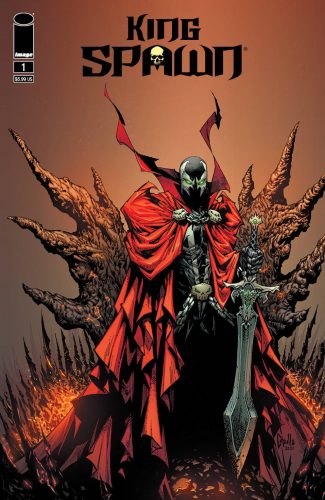 So Image Comics sent out a press release ballyhooing the immense order numbers for the imminent release of King Spawn #1:
So Image Comics sent out a press release ballyhooing the immense order numbers for the imminent release of King Spawn #1:
“The recent launch of Todd McFarlane’s new monthly comic book, King Spawn #1, has shattered sales records. With just under a half-million pre-orders by comic stores retailers, this marks the single largest new superhero monthly title launch in the comic book industry in the past 25 years based on the standard sales formula of the comic book industry (non-returnable, non-retailer exclusive sales).”
Hi! I’m a comics retail critter what lived through the excesses of the 1990s. I’ve got a few words to say about this event.
Todd McFarlane, creator of Spawn, is quoted in the release thusly:
“‘The numbers that came in were much higher than what I had projected. With sales that now have a historical impact in our industry. It proves that the character Spawn and the world he lives in still resonates to fans almost thirty years after I first introduced him.'”
If I may offer a counter conjecture…I believe the high sales (nailed down to 497,000 elsewhere in the release) can be primarily attributed to the 1-in-250 edition of the book signed by McFarlane. In other words (for those new to this) a store has to order 250 copies of the normal covers in order to have the option to purchase the autographed copy.
Looking at recent-ish Spawn sales on Comichron, it appears sales on the title are generally in the 35,000 range, though #293 at the beginning of 2019 was about 25,000. Now, #300 topped over 260,000, driven by multiple covers and, at least in my experience, duplicate purchases of those covers. This issues also seemed to be one of those at least lightly targeted by the current and mercurial speculator market, given the number of advance orders I received from customers for specific, and multiple, covers. Plus, it was a three hundredth issue, heavily hyped, which can boost not just retailer orders, but actual customer purchases.
The following issue, #301, was also hyped as a special issue, which goosed the sales a bit as well (about 186,000). Oversized issues, multiple covers, supposedly surpassing Cerebus‘s number of issues (though technically Cerebus only had 299 individual issues in its run, with “#112/#113” being a single publication…let the nit-picking pedantry begin!). EDIT: BobH points out Cerebus had another double-issue, so that’s 298 individual publications in the main run.
Orders remain higher than normal for 302, at over 50,000, but was back down to the normal 35,000 or so range afterwards. So, under normal circumstances, that is about our normal level for orders on Spawn. I suspect most retailers are ordering just about what they can sell on each regular issue, with not much variation from month to month (outside the outliers noted above). Each issue of late has had three to four covers, and there is a non-zero percentage of fans who buy more than one cover (something I’ve been going on about in detail in my variant cover-age series of posts, starting here).
From all this we can guesstimate the number of actual readers (or at least collectors) who consistently pick up Spawn. And it ain’t a half million people.
Spawn’s Universe #1, released a couple of months ago and the first of this new line of Spawn spin-offs, also had order numbers much higher than your typical Spawn issue. The press release states that “the first issue of King Spawn beat that number [of Spawn’s Universe #1 orders] by two and a half times,” which puts Spawn Universe at just shy of 200,000.
A look at sold eBay listings shows Spawn Universe #1, which has a cover price of $5.99, regularly selling for less than that…several in the four to five dollar range, the occasional copy for $1.99, and yes, a few for about $7 or so, with the occasional outlier in either direction. That tells me this is a comic unburdened by scarcity. Retailers ordered high (given the number of variant covers, and no idea which one would be the “hot” one of choice, it’s no surprise) and likely had copies left over. Hence, you get what is effectively clearance prices online, trying to move excess stock…not premium pricing in a seller’s market, where demand drives up pricing on limited supply.
This post is basically a long, winding road to say “there’s gonna be a shitload of King Spawn #1s in the marketplace.” That’s not to say it won’t sell an enormous number to customers. There are multiple covers, many sales will involve the purchase of more than one cover, and more people will be attracted to this new first Spawn issue than normally read Spawn.
But like I said above, the main impetus for these sales is almost certainly the 1-in-250 edition signed by McFarlane. Going by the provided order numbers, that’s just under 2,000 copies to which ol’ Todd has to apply his John Hancock. And I’m sure the cost of 250 copies (or the balance of 250 copies above what a store was already ordering) is probably worth it to get their hands on that signed comic, which will be slabbed and put up for sale for thousands of dollars.
Did I take the bait, and get one o’them signed funnybooks? I wasn’t planning to, but I had a customer who had to have it, and we knocked out a deal where, without going into too much detail, the numbers and money involved worked out for everybody. Does this mean I’m going to have way more King Spawn #1s than I planned on being able to sell? Yup…look, I’m a small comic shop, surrounded on all sides by other comic shops, some of whom I’m sure also bit the bullet and got themselves a signed copy. There’s going to be no shortage of King Spawn locally. Do I have a plan to unload them anyway? Sure I do…I mean, I suppose I could have made the guy ordering the autographed copy take a bunch, but…nah, he didn’t really want them, and I can use ’em, I think.
I’m sure I’m not the only store that did this, though I’m sure there are plenty of stores in bigger cities or with more robust mail order divisions who sneer at a mere 250 copies, and can move them easily. But overall, given what we’ve seen in regards to current market tolerance for special issues of Spawn…we’re probably looking at a couple hundred thousand more copies at least than can be easily absorbed.
Do I want it to sell well? Of course I do. Maybe a half million people will suddenly decide they need to see this new Spawn comic. Or maybe ~71,000 customers will buy each of the seven standard variants (and ~10,000 people will buy the 1-in-50 variants). Or maybe not. But certainly it’s going to sell outrageous amounts to customers.
And even when sales dip back down to regular numbers, that’s still four (yes, four…there’s another Spawn spin-off coming) comics instead of one, possibly a net gain. You know, minus the people who say “look, I could follow one Spawn comic, but not four, I’m dropping everything.” Think that doesn’t happen? I’ve been in this business 33 years…I’ve seen it happen. Plenty of times. Over and over again.
Anyway, that press release of Image’s doesn’t look like the crowning achievement they seem to think it is. It looks like the 1990s, where Marvel trumpeted their X-Men #1 orders, and their X-Force #1 orders, without mentioning how many ended up being warehoused, buried in storage lockers and occasionally being dragged out into daylight and into shops like mine to unload. I am sure no one’s hoping for that fate, but…well, let’s be realistic. They claim success, but retailers can’t help but see the cloud in that silver lining.
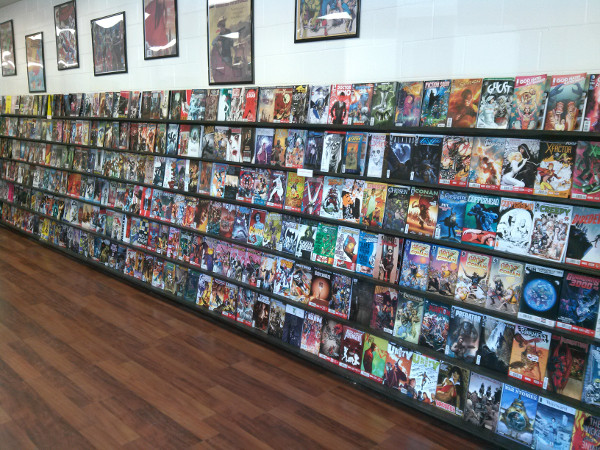
…Not like this question which kicked off a still-ongoing series of posts here, but something hopefully a little simpler:
How are the new comics displayed at your comic book store?
Now at my shop, I have a long, tall wooden rack with every cover full-face on display, side by side (pictured above).
I also have a standard spinner rack that I use to display the more all-ages books right by the front door, in which the covers overlap so that only the top half is showing. Here’s a stock image from Diamond’s site to show what I’m talking about, in the off-chance you don’t know:
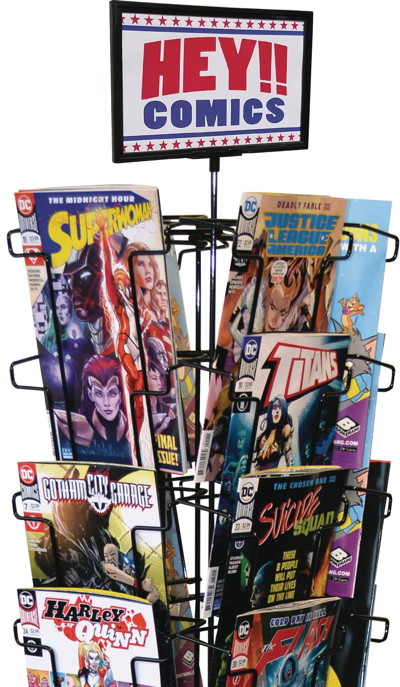
The reason I ask is that the other day I was sorta runnin’ off at the Twitter about corner boxes on comic books:
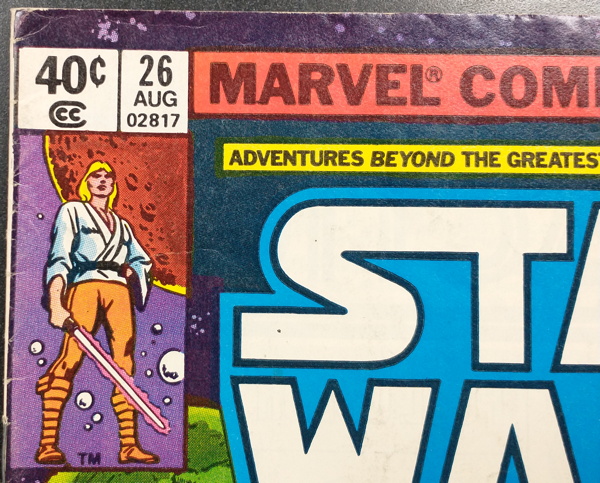
As I said there, the purpose of these was so that should the retail establishment in question rack the comics so that they’re side-by-side and overlapping, the corner box would still clearly identify the title even if the actual logo is obscured. I contended this was more common in newsstands and grocery stores and the like, whereas the direct market comic shops were more likely to display comics full-face (or at least on spinner or wall racks that would at least present the full logo). As such, there was not much call for the practical use of corner boxes, relegating them instead to a nostalgic symbol.
“Hold yer horses,” came the reply, however, from a Twitter pal what also sells funnybooks for a living. “Some comic shops, like ours, still do the overlap thing” (paraphrased slightly) and I’m forced to admit I occasionally do so as well even on my big ol’ rack. Ideally I don’t, as I prefer to face everything out ‘n’ unobscured, but there’s always a small percentage of them being overlapped. Thus, I am forced to admit, #notallcomicshops have entirely eschewed the overlapping strategy, for both space reasons and the simple fact there are a hell of a lot of comics coming out. I thought my giant rack would give me plenty of room, but every week I feel like I’m trying to squeeze more material on there.
So, after that long preamble, my question is this: how does your local shop display their new comics? I’m not so much concerned about the actual fixtures themselves (though I suppose it would be difficult to extract that info from the answer) but rather: are the comics primarily displayed with the full cover visible, only the top half visible (like in that spinner rack pic), or with just the sides visible (racked side by side but overlapping)? Or, God help you, are they just dumped into some short boxes for you to flip through and no covers are displayed?
I know there won’t be many either/or answers here. My store is mostly full-face display, with a single spinner rack that shows top halves, and sometimes I have to overlap things on the main shelf so only the left half of the book is showing. But, despite all that, the vast majority of the books are full-face displayed.
So what’s your local comics emporium like? Don’t need to name names (especially if their display is…well, awful) but I am curious as to what folks are doing.
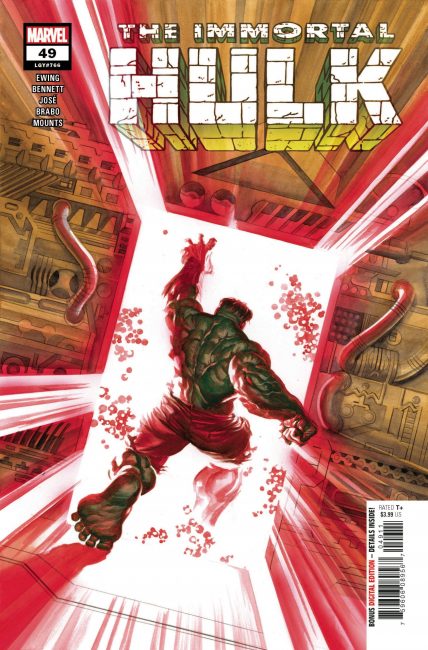
It’s a Special Album Issue, just like the good old days! Full-page illustrations combined with prose appearing in your otherwise regular Marvel funnybook…not a thing I’d like to see on a regular basis, but okay once in a while, especially if done well, like it is here, taking what could have been yet another Hulk-versus-heroes battle and applying some of the book’s usual levels of gravitas. One thing I liked is the opening (and continuing) comparisions between Bruce Banner and the Hulk with the Fantastic Four.
In an interesting confluence of events, Adam Warren, in his notes to Tuesday’s serialized page of Empowered, says
“…This does seem to represent a bit of a lost opportunity for superhero storytelling—that is, conveying how BLUDGEONING AND EARPIERCINGLY G-D LOUD that most cape-related conflict would be. Of course, the use of giant frickin’ sound FX and the like would burn up pagecount in a hurry, but this still seems like a narrative avenue worth exploring on occasion….”
And this issue of Immortal Hulk does just that, emphasizing the sounds of conflict, the drowned-out voices, et cetera…and given the illustrated text format of the issue, it manages to get around the sound effects problem that Warren posited. Thought that was a nice coincidence!
• • •
Joe
mentions, like I probably should have in Monday’s post, that the double-covered #2s had been a prominent feature during the “Heroes Reborn” year-long experiment with the Image Comics artists. Not just on the Reborn books, but on new title launches like
Thunderbolts (which I remembered) and he also mentions
Deadpool, which I didn’t remember and can’t find that it had a second cover (beyond having a newsstand “variant” with the standard UPC…am I missing something? Wouldn’t surprise me! ). Anyway, I should have noted when the two covers for the second issue started, and thank you Joe for stepping in.
Matthew asks
“Years ago I remember reading that for some period of time the second issue of the GI Joe series that Marvel put out was actually more valuable than the first issue because there were so many fewer issues printed. Was that ever true? Is it still true?”
Other commenters provided their answers, but I thought I’d answer here, too. Yes, there was a time when the second issue of Marvel’s G.I. Joe: A Real American Hero was commanding higher prices than the first.
Now I’m just working off my memories instead of, you know, doing research, but I believe the common belief was, true or not, that the second issue had a smaller print run that the first. And given that G.I. Joe was a relatively popular commodity at the time, it wouldn’t surprise me to find out that the first issue was in higher demand than expected, and retailers lowering the order on the second issue (without yet knowing how #1 would be received) resulted in the higher demand and comparative scarcity.
Contributing to this disparity in cover prices. Issue #1 was extra-sized and printed on nicer paper, selling at $1.50:
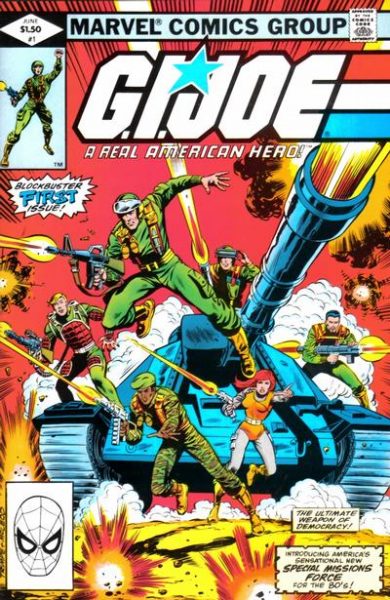
…and then #2 was the standard format comic at 60 cents:
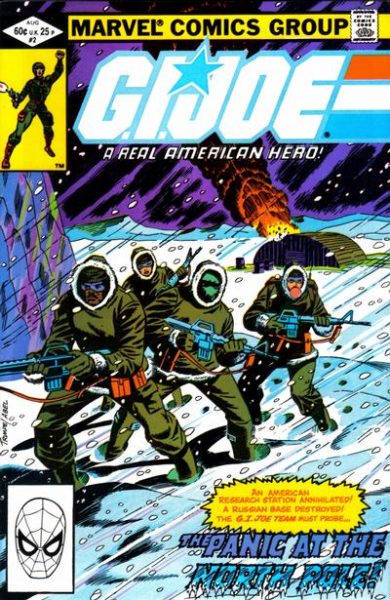
If I had to hazard a guess, backed up by literally no evidence whatsoever (though maybe I can peek through my fanzines from the period and see what sales on these were actually like) beyond my own proclivities as a comics retailer…I’d say that $1.50 price tag on a cartoon ‘n’ toy tie-in, two and half times the price of a standard comic, may have kept orders lower on the first issue. I mean, no matter how popular the property may have been at the time, there was no guarantee that would translate to comic sales of any note, and that high a price tag might have made the buying decision for anyone on the fence about it. And with that seeming barrier to entry, there was no reason to expect much repeat business for the second issue, even at the lower price.
Now please note that at no time am I saying the comic wouldn’t have had strong orders, or that it didn’t…just that the cover price may have kept them from being even stronger. And as it turned out, the first issue was very popular, enough so that there wasn’t enough of the second issue to go around, therefore low supply + high demand = $$$ for somebody. As a result, the price guide regularly had #2 listed at a higher price than #1.
But enough time has passed, with most early G.I. Joes being in less reliable availability at your local comics emporium, that the whole “lower print run” thing, if it ever actually was a thing, is of negligible importance in today’s market. #1 and #2 are both equally difficult to come across, and with the back issue market becoming increasingly focused on “number ones” and “key issues,” it’s not much of a surprise that prices for that first G.I. Joe have zipped on past those for the second.
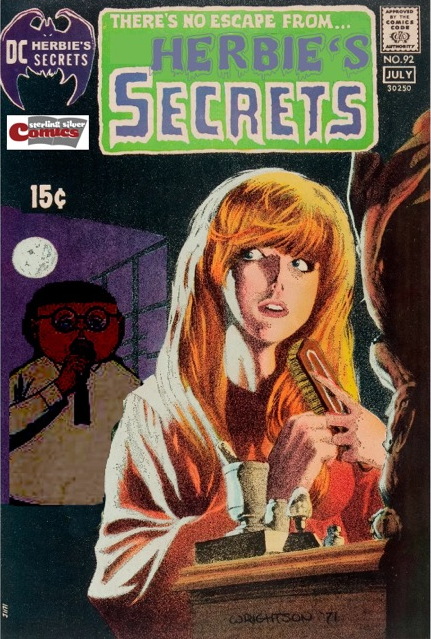
Thanks to reader/mad genius Paul for sending this mock-up of what could’ve been for a Sterling Silver Comics retailer exclusive variant!
Following up on my discussion about that very topic from Monday, I’d actually pulled up an email I received from A Comics Publisher in response to an inquiry I’d made along these lines. Without going into a whole lot of specific detail, let’s just say my buy-in, just for the minimum copy purchase of the exclusive variant, would have been in excess of $10,000. That doesn’t count other minimum orders for the regular cover or other variants of your retailer variant, or for paying for the actual artwork by the artist.
Basically, it’s a lotta scratch…not undoable, entirely, but certainly an investment that would require some first class hustling to make that cash back. Which could be a problem in case you got a cover that didn’t grab the attention of the sort of folks who look for exclusive variants like this. But, to be honest, the way the marketplace is right now, seems like anything that has any form of scarcity is automatically in demand.
Anyhoo, something to think about the next time the opportunity arises.
But speaking of “scarcity,” apparently the latest issue of Usagi Yojimbo, #20, is “in demand” due to it being a first appearance of a character whose name I bet most of the people looking for it couldn’t even tell you. My distributor decided, alas, that this would be one of the comics they’d be shorting from my order last week (there’s usually a few every shipment). I figured that would be that, given it’s temporary hotness and all spare copies eaten up by reorders, I’d have to wait for the second printings to come along so I can get copies for customers who actually want to read it. Somehow, though, miracle of miracles, my replacements showed up! I mean, sure, half my Fireflys are missing and several of my Marvel Voices: Pride shorted or damaged, so it’s always something.
As to the Marvel Voices: Pride comic, it surprised me a bit by including select pages from Alpha Flight #106 (1992). In case you forgot, that’s the comic where Northstar finally just straight up said, after years of subtle-ish hints, “yeah, I’m gay.” Which was, granted, a pretty big deal, and demand for the issue warranted a second printing. But this was also at the height of the whole “gotta be EXTREEEME” art thing, and…yeah, it certainly looks a bit jarring side-by-side with more current art styles. Hey, gotta start somewhere! (Also, did they ever bring back Major Mapleleaf from that story?) (Yes, I know that was a nickname of Alpha Flight’s Guardian at one point.)
I should also note that my comments sections here on Rogressive Pruin occasionally take on a life of their own. So, if you ever wanted to delve deep into the origin of the word/sound/expression “vootie,” well, your day has come.
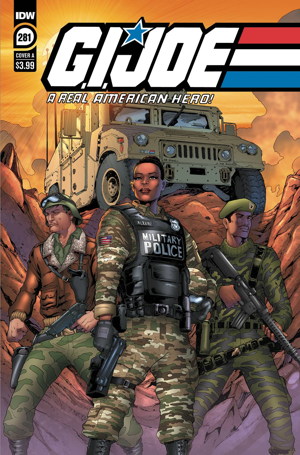 Monday I started getting emails and Facebook messages and stuff from folks asking for G.I. Joe #281, releasing this Wednesday from IDW. I sighed just a little, because by now I know what this means…some member of the elite comics-noscenti somewhere on an app or on the YouTubes has singled out this issue as “a hot collectible” and here we go again.
Monday I started getting emails and Facebook messages and stuff from folks asking for G.I. Joe #281, releasing this Wednesday from IDW. I sighed just a little, because by now I know what this means…some member of the elite comics-noscenti somewhere on an app or on the YouTubes has singled out this issue as “a hot collectible” and here we go again.
And sure enough…checking eBay right now, Tuesday evening as I type this, the “regular” covers (the freely-orderable A & B variants) are selling for between $10 and $20 or $30 or so, and someone has the 1-in-10 variant up for a C-note. When I checked on eBay Monday, when I first started receiving the requests, the regular covers were still at cover price, so things changed fast. (The 1/10 variant was listed for high prices then, too, to be fair.)
Why is it in demand? Well, it’s the typical trigger for speculation of late: the “first appearance,” this time of a new Joe named Sherlock. Haven’t seen a picture of him yet, and flipping quickly through the book didn’t reveal anything obvious. He might even be on one of these covers, I have no idea. I’m just hoping it’s a guy in your standard military fatigues but wearing a camouflage deerstalker cap.
So here’s the thing. This is issue 281 of a regular monthly series. It’s been going on for, like, a decade, picking up from the original numbering (and continuity) of Marvel’s G.I. Joe run. Most retailers have plenty of sales history on this book.
Meaning…I suspect most retailers didn’t order too far above what they actually sell. I know that, for years, I have sold essentially the same numbers on this title month-in, month-out, with maybe a one issue variance. After pulls, I’ll have one copy left on the rack. Most of the time it goes unsold and into the back issue bins. Once in a blue moon someone will buy it. Thus, at best, I’ll have one extra copy not spoken for.
Therefore, the second trigger for speculation is in place: scarcity. Probably the big mail order houses stored up some extra stock, but plain ol’ shops like me weren’t about to load up on it. Even if you told me months ahead of time “they’re gonna introduce a new Joe!” who would have thought “oh, yeah, issue #281 of this series, that’s the one that’s gonna attract all the attention!”
Sometimes you take chances on orders, but they have to be reasoned, educated guesses, based on what you know, not based on whether or not some random issue is going to attract the attention of investors. I actually ordered a bit higher on Batman/Fortnite than I would have of a Batman mini-series, or of a video game tie-in book. I’ve had customers over the years ask for Fortnite comics, and I knew that game was popular, so I gave it a shot. Turned out, this time, I was thinking in the right direction but not nearly enough…could’ve used a lot more copies. Apparently I was better off than a lot of stores, though.
At the previous place of employment I did the same with My Little Pony #1. I figured “this is a hot property, we have lots of kid customers…I’M GOING FOR IT.” I ordered a ton, and they all sold. Then again, I thought Superman Unchained would do better than it did…lots of great variants, Jim Lee art, the whole shebang. Now, as it turned out, we didn’t lose money on the comic, but we had plenty left over.
Those were decisions based on what I thought I could realistically sell, given the nature of the comics themselves, and what I thought would be our customer base’s response to them. It’s nearly impossible to anticipate fluke demand, that suddenly everyone’s going to decide they want the same single issue of a comic they’d never wanted before.
Even if you decide “a-HAH, I’ll just order more of every first appearance!” or “I’ll just order more of what these YouTubers/apps suggest!” that’s no guarantee those sales will materialize. In fact, quite the opposite…as I said, one of the triggers is scarcity. This speculative demand isn’t going to show up for a title sitting thick on your shelves. It’s going to show up for your G.I. Joe #281s, that you barely ordered to fill your pull lists and had one left over for the shelf in the off-chance someone else wanted it.
ADDENDUM: a while back one of my regulars dropped G.I. Joe from his pull list, after having it on there for many years, even dating back to when he was my customer at the previous place of employment. Figured I’d finally have to adjust my G.I. Joe orders for the first time in forever…’til about a day later someone started a new pull with me primarily so he could start getting that G.I. Joe series.
I called this the “Law of Conservation of G.I. Joe.” Please keep an eye out for my TED talk.
Whenever I extol the virtues of Free Comic Book Day, I am frequently asked questions lke “what good does it do?” “Does it really help your business?” “Do you ever get regular customers out of it, or do the new faces just show up to load up on freebies?”
In the simpler, easier-to-quantify short-term benefit, a Free Comic Book Day event makes my store a great deal of money. While the “free” comics I give away cost very little per individual unit, en masse, particularly in the quantities I traditionally purpose…well, it ain’t cheap. However, it’s always a worthwhile investment in that it attracts a lot of people to my shop for that day, most of whom take advantage of the store-wide discounts on products I’m actually selling. Along with the handfuls of free comics, many also walk out with stacks of graphic novels or back issues that they’ve also purchased. As I often say, I have never lost money on a Free Comic Book Day.
Aside from the financial considerations, there are the emotional ones. Free Comic Book Day makes people happy. Yes, happy that they’re getting free stuff…but they’re happy to be getting comics, they’re happy to be at the shop, it’s a big event that’s very exciting and cheerful.
And now we get into the long-term benefits. People will remember that happiness. That there was this cool shop in town that gave away a bunch of free stuff. That the Free Comic Book Day promotion itself caused them to find out if there was a comic book store in their area, who then sought out and visited my store for the first time. And now, those first-timers now know where to go for comics should they ever need any again. Plus, they’ve got friends they can tell about their experience…a little good word-of-mouth advertising is always welcome.
I don’t think anybody expects Free Comic Book Day events to create new weekly New Comics Day regulars, snapping up a dozen or so books every Tuesday/Wednesday. That habit is…kind of a lifestyle choice more than anything. But it does generate returning customers. I have had people specifically cite Free Comic Book Day to me as their reason for returning to the store to pick up something or ‘nother. I’ve had them tell me “I was going to buy this on Amazon, but I remembered getting free comics from you, so I’d rather spend my money here.” Yes, really.
So no, Free Comic Book Day doesn’t immediately convert all new faces into weekly visitors. But it does positively promote the store, either informs or reminds people that a comic shop lurks waiting in their midst, and that my shop is a nice, clean, and friendly place to go if comics are needed. It is a long term gain.
And thus it is the same with Batman/Fortnite.
The big problem is supply. Even I, who ordered much higher numbers on this than I would have on a typical Batman mini-series, still sold out quickly. So, unlike Free Comic Book Day, where everyone who came to the store left with what they wanted — free comics and discounted goods — many B/F seekers left without the item for which they were hunting.
In that circumstance, it may seem like it’d be difficult to put a positive spin on the shop for the disappointed customer. However, friendly service, an offer to hold future issues, and just generally offering as good an experience as possible, all things considered. I can tell you I didn’t have one angry, or even all that disappointed, customer after learning I was out of B/F. Well, okay, I had a couple of folks grumble at me because I wouldn’t let them buy a half-dozen copies of it for flipping on eBay, but that’s not the sort of customer I’m worried about here. Even if I didn’t have the product, I want new customers to know that it’s a nice store with a fella behind the counter what’s trying to be as helpful as he can manage.
On the other hand, what of the people who were lucky enough to get a copy at my shop? They were certainly happy to get a copy, at cover price, and like the new faces at Free Comic Book Day, they’ve learned there’s an inviting comic book store in town.
Again, no, they’re not likely to suddenly become regular visitors to the shop outside the B/F context…but you treat them well anyway, and, whether they were able to immediately fill that B/F need or not, they are more likely to remember you when they need something comic book-y for whatever reason. Even if it just another Fortnite tie-in comic book.
And rest assured, Batman/Fortnite is essentially like printing money for DC. There will be more of this sort of thing. And when the time comes, and, I don’t know, that Superboy and the Ravers/Fortnite crossover comic is finally released, where will the customers for that be more inclined to go? The comic shop that screwed them over by jacking the price up to $30 or whatever the last time a Fortnite comic came out, taking advantage of an excited kid or a desperate parent? Or the shop that sold ’em for cover price when they had it, and offered to save future issues and reprints of issues they missed? The shop that made you feel bad about buying a comic, or the shop that made you feel good?
I don’t buy the excuse that the inflated prices on Batman/Fortnite are no big deal given the money gamers usually spend on their game-related products. So what? Just because you can get away with something doesn’t mean you should. There’s no legal reason to not charge whatever you want on a comic book…otherwise, the back issue market would be markedly different, wouldn’t it? But a brand new comic, literally the day of release…for me, that’s an ethical consideration. It’s…well, it’s scummy, is what it is.
Robin #1 and Star Wars: War of the Bounty Hunters are a couple of recent hot comics that got the speculators all hot and bothered lately. What if on the day of release I bagged ‘n’ tagged them with $25 price tags? You know what that would make me? An asshole with unsold copies of Robin #1 and Star Wars: War of the Bounty Hunters on my shelf, that’s what. Would some people still buy them? Probably…$25 is probably a small investment after getting their copies in those CGC coffins and up on eBay for $200 or what have you. But the folks who just wanted to read the comic, and maybe don’t have the budget for those obviously smartly market-valued collector’s items? Well, fuck ’em, right? Gotta grab that cash while the grabbing is good!
Sorry, I want to sleep peacefully at night. And I want people who come into my store to leave with happy thoughts about their experience, making them more inclined to return, or recommend me to others. That is the long-term gain from treating people well, and not taking advantage of them when their need is great and you hold all the cards. As reader John said, “Don’t Be A Dick,” because folks will remember if you are one.
I look forward to seeing at least some of these new customers back in my store in the future, after this Fortnite comic thing is done. Because experience tells me that I will.
Well, I was going to answer a question about variants someone left in the comments to Monday’s post that I thought would be simple, but it started turning into a book and I’m not even sure I was close to being done, so…let’s put that on hold ’til Friday, after I’ve thought about it for a bit.
As for your latest Batman/Fortnite comic book news: yes, #2 is out this week, Yes it’s still in demand. Yes, still don’t have enough to go around, though from the sounds of it I was one of the few stores around here to actually have any kind of significant quantity of them ordered. Not nearly as many as it turns out I could have used, but I guess I was better off than most. Adding more customers to preorder lists, and will need to start calling a few folks to remind them that, yes, I am holding copies of #2 for them and they should come pick them up.
What’s nice is that at least a few of the Fortnite customers are buying other comics, so it’s not just kids ripping open their copies to get the codes and then setting fire to what remains. I mean, sure, most of them are doing that, which, y’know, fine, but if even a couple of new readers result, I ain’t gonna say “no.”
I was recently turned off of a podcast from a noted professional sporadic comics generator, which I’d been enjoying despite (or maybe because of) the not-always-justified self-aggrandizement and some…glossing over of certain points of the ’90s comics industry. But his enthusiasm was entertaining, and hearing his side of what was happening was educational…and, y’know, fans have been shitting on the guy for decades, if he wants to put out a podcast talking about how great he is, hey, more power to him.
But a recent episode discussing the Batman/Fortnite phenomenon and how some of his retailer buddies were dealing with it really left an unpleasant taste. While talking about all the new customers coming in the doors, he’s also saying how these retailers are charging $20, $30 or whatever a pop and essentially giving his approval of this.
I get that everyone was caught short on this comic, and that sellers are making a killing on eBay with these, but…the one thing the industry has desperately wanted is kids putting down Those Darn Vidya Gabes and buying comics again, and when they do…we start gouging them for as much cash as we can grab? Or, rather, their parents? What’s that going to leave them thinking about comic stores? Or with the comics industry in general? It’s…well, it’s gross, is what it is. I know, “supply and demand” an’ all that, but maybe a little long term planning over short term profits would be the preferable strategy.
I limited copies to one per customer, and took down lots of names for future issues. Or for reprints of already released issues if the first prints weren’t available, because the best part about all the Fortnite kids is that they don’t care what printing they get. The codes are the same in all of them. And I will sell them all these issues at cover price. End result: happy customers who’ll come back. Haven’t had a single person mad at me about the whole Fortnite situation. Maybe I’m just in a laid-back part of the country, but talking to folks who come in looking for the comic, explaining the situation, and offering to save issues as they come in seems to have a mollifying effect.
Anyway, I know this has all turned into something of a mess, but starting within an issue or two, once we start getting in the installments we were able to order once we realized how much demand existed for the book, there should be plenty to go around. In fact, I’m expecting a glut, as retailers probably went to far in the other direction ordering more than they could possibly sell. In addition, the buyers who are picking copies up out of pure speculation right now will drop off then, as only the relative scarcity drove those purchases.
So I always hear about it when I criticize retailer behavior (remember “not buy?” Sheesh, that was stupid) but since nobody reads blogs anymore, I guess, maybe I can get away with it this time. But honestly, the next time we get a huge influx of new potential customers, hopefully we can all put our best foot forward, y’know?
If you’re trying to decide “what’s the most famous example of variant comic covers of all time” — first, c’mon, what’re you doing with your life, and second, I think just through the sheer magnitude of copies that were unleashed upon an unsuspecting public, it’s gotta be 1991’s X-Men #1:
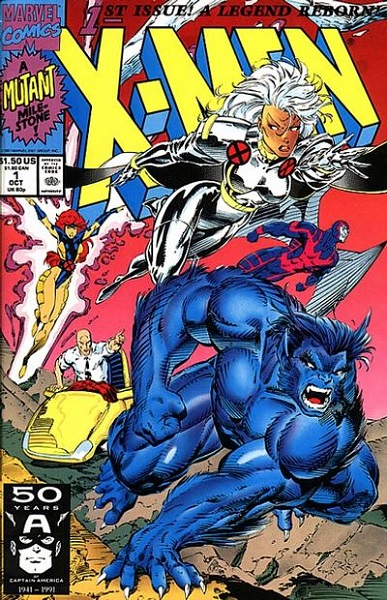
There were four different covers produced, the first three featuring a different mix of members of the team, with the final cover presenting their arch-nemesis Magneto. The four covers formed a single image when connected together, but if you didn’t trust your hand-eye coordination to assemble so complex a puzzle, Marvel had your back with the fifth variant: a gatefold cover that opened up to present the full image.
Unlike Spider-Man #1, the covers weren’t released all at once. Instead, Marvel decided to dominate comic sales for over a month by releasing each cover one per week, starting with the A, B, C and D covers (as they are usually referred to), culminating in the gatefold cover in the final week.
Orders were gargantuan. In total, over 8 million copies were produced, though as has been noted by multiple observers, and just through my own personal observation, a good chunk of those remained in retailers’ hands.
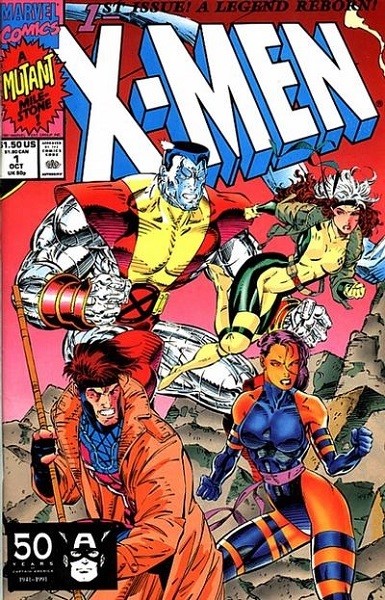
Speaking of personal observations, I’ve written in the past about how once impossibly-common comics from the ’90s marketplace are becoming slightly less easy to find in the wild, simply due to the attrition of stores that were active then having shut down in the intervening decades and taking their backstock with them. I’ve also written about how many of the people buying comics at the time either had no idea how to take care of their comics at the time (despite the wide variety of comic storage supplies being offered, and purchased, in sizeable amounts), or simply neglected their collections and let them fall to disuse and ruin over the years.
The point being…a comic that was once so commonplace and contemptuously familiar that copies were given away free with purchases is now, kinda sorta, becoming “collectible” again. Not to keep referring to things I’ve said in the past, but I’ve said in the past that even without actively buying copies of X-Men #1 in collections, I’m accumulating a backlog of it. And I’d say only abut a third of the copies I’ve seen have been in Near Mint or better, and when you actually have a copy in Near Mint (and not, say, VF- which you’re calling “Near Mint”) it can sell for a pretty good price nowadays.
Again, this all depends on local supply. There are probably still plenty of areas of High X-Men #1 Concentrations where they flow like water, and you merely need to dip your hand in a stream to retrieve a copy or three. And they’re all over eBay, natch. But, in areas populated primarily by newer stores, where even the bespectacled old men who have direct memories of those times and will gladly share them with you (ahem), they may not be as in deep a stock as they historically had been.
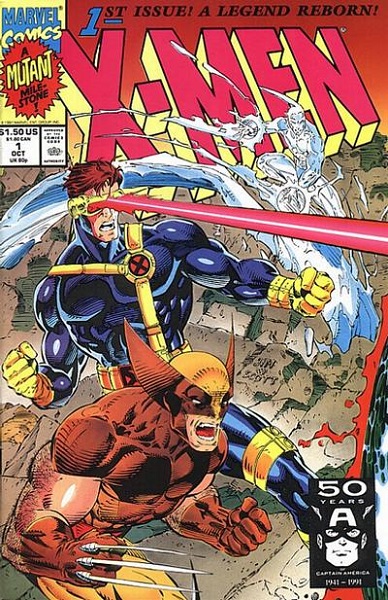
It was a large confluence of causes that resulting in this massive amount of orders:
- The ’90s were a boom time for collectible comics, with a huge influx of new customers driven to comic shops primarily by the 1989 Batman movie, with earlier successes like Dark Knight, Watchmen and Teenage Mutant Ninja Turtles helping to push the expanding market as well.
- It was the time of The Hot Artists, and Jim Lee may have been the hottest artist of the time. Launching an expansion of Marvel’s popular franchise with Lee on art chores couldn’t help but grab market attention.
- The investors were out in force. The aforementioned Teenage Mutant Ninja Turtles arguably kicked off a new wave of folks looking to make their fortune trading in “rare” comic books, and what could be rarer than eight million copies of X-Men #1? Okay, nobody knew it was going to sell that many copies, but it was a pretty easy guess that it was going to move some large numbers. That didn’t stop people from buying boatloads of copies in the hopes that they’d be able to turn them into houses or kids’ college funds down the road.
- This may be hard to imagine, but there was a time in comics publishing that when a new series was launched, the expectation was that the series would continue so long as sales held out, and maybe if sales dipped a little, the publisher would try things like “new directions” or “fresh creative teams” or more promotion to support the book. The idea that new #1s for titles would flash by like strobe lights was not one that was considered. As such, retailers would order plenty of first issues of titles, as that would likely be the most sought-after number in the back issue bins over the years, and hopefully decades, of the title’s life.
- And yes, the multiple covers. Outside of investors, just plain ol’ folk who bought comics and weren’t necessarily looking to turn a buck. As I brought up early on this ongoing series of “variant covers” posts, having different cover images was a way to encourage the regular reader to pick up more than one copy of a particular item. Plus, having the additional twist of making all the covers connect into a larger picture…it’s a cunningly evil plan that, I can tell you at least from my memories of selling the things at the time, worked quite well indeed.
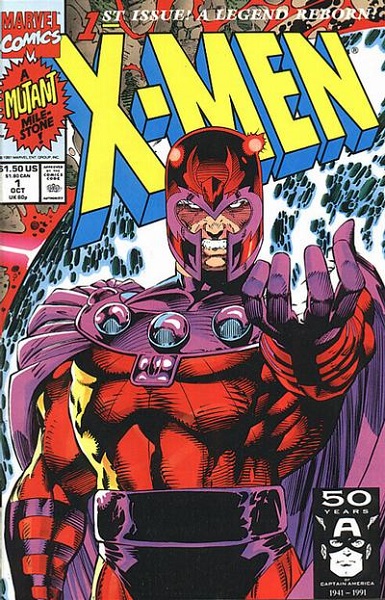
Some have pointed to this as being one of the causes of the ’90s market crash, and…I don’t know, I think there may be worse offenders (I won’t say any names, but the initials stand for Deathmate) since, all things considered, X-Men #1 actually sold (though again, not nearly as many as were ordered). There were bigger stinkers out there, at least to the point that X-Men wasn’t seen as a flop, whereas something like Turok: Dinosaur Hunter was. That said, I’m sure enough people got burned on their investments on ’90s comics, including X-Men #1, that they, and their money, fled the marketplace, reducing cash flow and feeding the crash.
So wither X-Men #1? It remains a popular seller, as do assorted issues from the 1991 series as a whole. There’s a whole new audience of comic book buyers and X-Men fans who weren’t around thirty years ago when this series launched. And there are plenty of customers who were around but misplaced, sold, or damaged their copies in the meantime and want replacements. And, of course, there’s the current wave of speculation mania driving sales on any “key” and/or first issues.
I don’t always have every cover in stock, but I usually have at least two or three different ones on hand. The cover I see the least? The gatefold cover. The one I see the most? Surprisingly, the fourth cover with Magneto, given that, according to this article, it was the poorest selling of the first four. And that gatefold cover was the highest selling. Huh, go figure. (Again, it all depends on how many copies actually got into people’s hands, and didn’t disappear with the retailers who ordered them.) It’s my memory that, as each cover was released every week, sales dropped a little with each one, with a boost on that final fold-out issue. But I could be wrong…it’s been 30 years, after all.
And which cover did I buy, since as a 1990s comics buyer you were legally required to buy at least one copy of X-Men #1? Why, the gatefold edition, of course…I wasn’t going to miss out on any of that artwork!
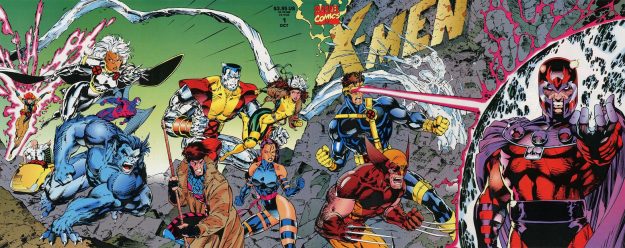
Next time in my variant cover-age, even though John kinda beat me to the punch: Robin comics! A whole lot of ’em! Holy gimmick covers, Batman!
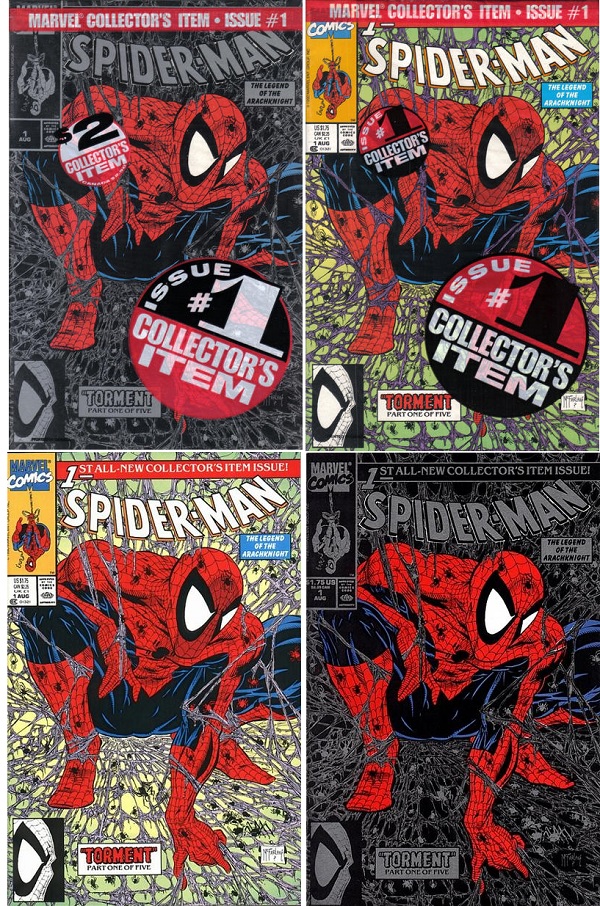
So in the summer of 1990, these came along: the first issue of what we referred to as the “adjectiveless Spider-Man, a new ongoing series drawn and written by the immensely-popular superstar artist Todd McFarlane. If you were a fan of McFarlane’s art, it was absolutely a visual tour de force, giving you the most McFarlane-est of McFarlane Spider-Man art. The writing was…well, I think in retrospect ol’ Todd got grief way out of proportion to his actual scripting skills. Perhaps he wasn’t the most talented wordsmith in the world, but for a goofy ol’ Spider-Man comic, it was fine. I’ve read plenty worse, I assure you. And while the opening captions to issue #1 took the brunt of the derision, it was turned into a wonderful piece of audio by my old pal Andrew and thus, how can I ever feel anything but love for it?
But look, we’re not here to talk about the contents of these Spidery-Sam books, we’ve come to poke sticks at the variant covers! Of the 1990s Big Variant Cover Hoohas, Spider-Man #1 was the first, with two differently colored covers (one printed with in green and black, the other black with silver ink), and then two additional versions with each cover sealed inside a polybag with “COLLECTOR’S ITEM!” printed all over it. Note the “Legend of the Arachknight” blurb, clearly referencing DC’s Legends of the Dark Knight #1 and its multiple covers.
Of note is the fact that the black bagged variant had no price printed on its cover, but instead had a $2 price tag on the bag. Gettin’ ya for an extra quarter there. The green bagged edition still appears to be the regular $1.75 price, though I could have sworn both were $2 at the time. Hey, it’s been thirty years, I forget things. However, for that extra quarter, you were buying a comic that was genuinely a variant in that the actual cover had a printing variation. But if it were removed from the bag, technically the collectible would be “incomplete,” so just being a variant in and of itself wouldn’t be enough, I’d thought. But just checked the eBays and someone there is trying to sell one of unbagged, cover-priceless versions of that black ‘n’ silver variant for $70, but I don’t know if that’s within reason or simply “high hopes.”
And yes, there’s also the bagged newsstand edition, with a UPC code on the cover instead of the Spidey face in its place. Can’t forget that. Plus there was the gold-inked 2nd printing, and the platinum edition and newsstand gold edition that you can read about here.
At any rate, we definitely sold a boatload of things…just stacks and stacks, with plenty of folks grabbing multiple copies. This was, of course, back in the day when you ordered heavily on a first issue, as, if successful, the series would go on for a long time and there would always be customers looking for that first issue in the future, because surely no publisher would be dumb enough to relaunch a series with a new #1 every year or two. In these days of direct market frugality, where everyone’s ordering as close to the bone as possible, it’s hard to imagine actually having that much stock on anything new, much less having speculators look at said stacks and view them as investible material. Compare to today, where speculation depends on pouncing on titles ordered at low-ish but reasonable numbers, creating and taking advantage of that additional scarcity in an already thinly-spread marketplace.
At the time, my previous place of employment had plenty on hand. Of the two regular covers, at least…my boss thought the polybagged-editions were “stupid” and refused to have anything to do with them after the sold out. Just wouldn’t buy them from collections, that sort of thing. Eventually we did get two that showed up in a collection that we just sort of ended up with, so out into the back issue bins they went. I think that was the one exception.
My personal thought on those bags back then was that they would eventually do damage to the comics inside, as they aged and broke down and decayed on the comics themselves. In recent years I’ve had my hands on those polybagged Spideys in my own shop, as well as other prebagged comics of that decade, and it doesn’t appear as it this has been the case. Whether that’ll change in the decades to come…well, of course it will, it’s cheap plastic, it’s gonna break down eventually. Whether that’ll happen soon enough for any of use to care, I don’t know.
I’d said the McFarlane Spider-Man #1, and the rest for that matter, were plentiful at the time. Not to beat that poor old dead horse some more, but after thirty years and shops vanishing and new shops cropping up and old back issue stock going away and all those copies purchased but then those were either not well cared for or simply thrown out…it’s very possible the available stock left in the world is at least somewhat lessened. Add to that the younger customers who weren’t around or too wee to be buying these off the racks, and are discovering them now. Regardless of the reason, these Spider-Man comics are currently in high demand, at least for me. I just can’t keep the darn things in stock.
And do those variants make any difference to buyers now? Not that I can tell. I haven’t had the quantities on hand to make a clear judgement as to whether there’s a consumer preference for the green cover or the black cover, but both (and the gold reprint) sell nearly as soon as I price them. This is, I think, one of those cases where cover variation is playing no real part in sales. It’s all “early McFarlane art,” or “it’s a #1 for one of the main Spider-Man series,” or “it’s a major Marvel #1,” period, all of it pushed along by a not-insignificant number of current speculators.
Next time: weekly X-Men variant covers…advantageous!
« Older Entries
Newer Entries »

 So Image Comics sent out a press release ballyhooing the immense order numbers for the imminent release of King Spawn #1:
So Image Comics sent out a press release ballyhooing the immense order numbers for the imminent release of King Spawn #1:






 Monday I started getting emails and Facebook messages and stuff from folks asking for G.I. Joe #281, releasing this Wednesday from IDW. I sighed just a little, because by now I know what this means…some member of the elite comics-noscenti somewhere on an app or on the YouTubes has singled out this issue as “a hot collectible” and here we go again.
Monday I started getting emails and Facebook messages and stuff from folks asking for G.I. Joe #281, releasing this Wednesday from IDW. I sighed just a little, because by now I know what this means…some member of the elite comics-noscenti somewhere on an app or on the YouTubes has singled out this issue as “a hot collectible” and here we go again. 











